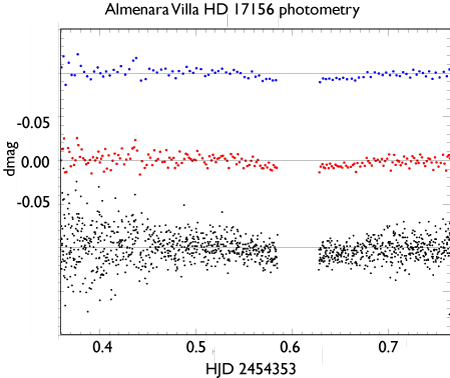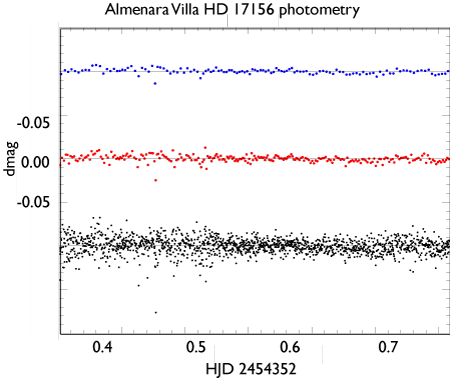
In the last post, I pretty much wrote off HD 17156 b, which was the subject of last week’s transitsearch.org photometric follow-up campaign. Ron Bissinger observed the star during the latter part of the transit window, and saw no evidence of a transit. Tonny Vanmunster wrote with the news that Belgium was clouded out.
Soon after the post went up, however, Jose Manuel Almenara Villa of the Instituto de Astrofisica de Canarias posted a comment:
Hi Greg,
I observed HD17156 in the transit window. Unfortunately the night was windy, affecting the small telescope so the photometry is not so clear as we would wish. Anybody else observe?
It’s possible that I have a central transit. I can show you some plots if you want. I will try to observe again on December 3 (I think that is my next opportunity).
Regards,
Jose
On Saturday, Jose sent me his photometric plots, I should point out that he emphasized once again that the night was windy. In his plots (I’ve rewritten the labels in illustrator so that they show up better on the narrow blog-page format) the black dots are individual observations (R filter, 7 s exposures), the red dots bin 6 observations, and the blue dots bin 12 observations.

On the night before the night of the transit window, he got baseline photometry which shows considerably less scatter, and which does a nice job of showing his excellent photometric technique:

He fit a simple trapezoidal transit template to his data. The resulting fit has a duration of 169 minutes, a depth of 0.007 magnitudes, and a mid-transit time (HJD) ~ 2454353.614. These values are all quite close to what one would expect if HD 17156 b really is transiting. The possible event ends just prior to the start of Ron Bissinger’s time series.
So what to think? It’s most important to reiterate Jose’s point that the weather was not particularly good, and that a block of critical data is missing during the event itself. I myself have contracted transit fever several times in the past, and have built up sufficient immunity to refrain from getting too excited. I think a conservatively realistic assessment would say that there’s still an 11% chance that HD 17156 b transits are occurring, and that the uncertainty in the window has been narrowed down significantly. Over the long run, if transitsearch.org is going to succeed, then its important to stay cautiously optimistic. The good thing about a transit is that it repeats with clockwork regularity (barring the unlikely, but tough-luck situation where dynamically induced precession of the node induces transit seasons.) The next chance to observe HD 17156 during the transit window falls to North America on Oct. 1, where hopefully there’ll be multiple observers on the sky. We’re bad – We’re Nationwide…
To end on a heartfelt note, I think that the global collaborative efforts that go into these transitsearch campaigns have been both fun and inspiring, even when the result is the high-probability flat-line light curve. It would be exciting, though, if Jose ends up leading a discovery paper with the other participating observers as co-authors.

Very interesting, if weather permit, I will give it a try on Oct. 1 .
Also one questions, by someone´s calculation, on average it will take monitoring a few thousand stars to discover another hot Jupiter. With todays computer power and equipment, that should be relatively easy, but yet we have discovered only 10 or so transiting planets, so I must be missing some important points. Would anyone be kind enough to educate me? Thanks.
Way to go, Jose! Wishing you better weather conditions on your next observing run.
Eric